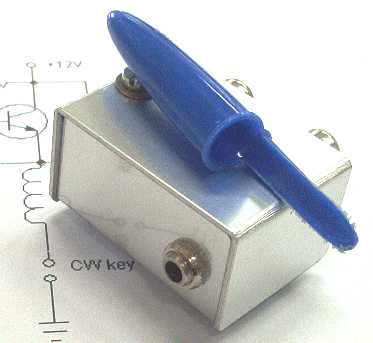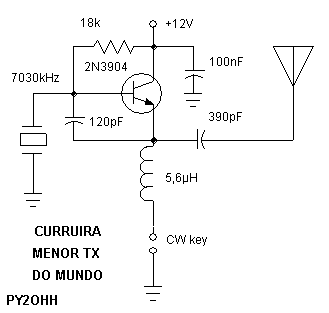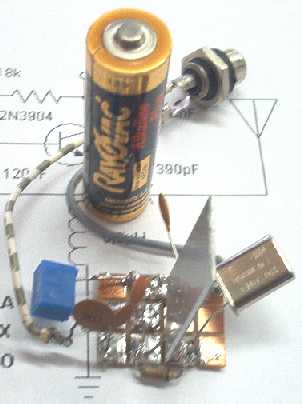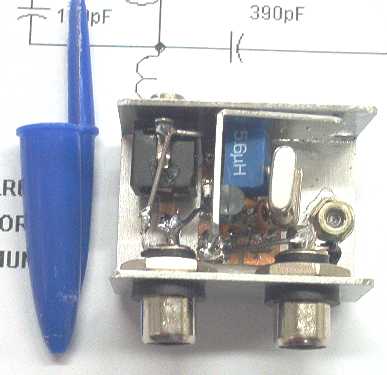

THE CURRUIRA
After the CANARINHO success we decided to build a transmitter with the lowest number of discrete parts. So we arrived to the CURRUIRA.
There are only 7 parts !

Look at the size compared with a BIC tip cover
The circuit

It is a crystal Colpitts oscillator with almost all deleted !
We can get even 700mW with a good size aluminum heat sink glued to the flat size of the 2N3904.
We achieved to work several Sao Paulo, Rio and Minas Gerais stations always providing an intelligible signal and hooking in a QSO.
In the way it is described we get 0.5 Watt, remembering the transistor can be changed by other with higher power, or even vary the base resistor, the lower value the higher power output.
In this circuit due to the low power involved we did not add a low pass filter (PI) in its output, in order to lower the parts count. If the power is raised we recommend the usage of the low pass filter.

Prototype

CURRUIRA opened : in L the 2N3904 heat sink, lower left the DC power connector; over the power connector the CW key connector.
Blue => 5,6ÁH inductor
We would like that if any friend got to build this TX, he/she would tell us the results.
73 everybody
Miguel
In time this TX will turn into a transceiver... wait for it !

O CURRUIRA
Depois do sucesso do CANARINHO resolvemos montar um transmissor com o menor número de componentes discretos. Assim chegamos ao CURRUIRA.
São 7 componentes !

Veja pelo tamanho da tampa de caneta BIC
O circuito

Trata-se de um oscilador Colpits a cristal com quase tudo eliminado !
Podemos tirar dele até 700mW com um dissipador de alumínio de bom tamanho colado na face plana do 2N3904.
Conseguimos trabalhar várias estações de São Paulo, Rio e Minas Gerais sempre colocando um sinal inteligível e manter um QSO.
Da forma que esta descrito tiramos 0,5 Watt, lembrando que o transistor pode ser alterado para um com maior potência, ou então variar o resistor de base, menor valor maior potência.
Neste circuito devido a baixa potência envolvida não colocamos um filtro passa baixas (PI) na saída, afim de diminuir o numero de componentes. Caso a potência seja aumentada recomendamos o uso do filtro passa baixas.

Protótipo

CURRUIRA aberto : em L o dissipador do 2N3904, a esquerda em baixo alimentação de CC ; acima o conector p/ chave CW.
Azul => indutor de 5,6ÁH
Gostaria que caso algum colega viesse a montar este TX que nos informasse dos resultados.
73 a todos
Miguel
Em tempo este TX esta virando transceptor... aguardem !